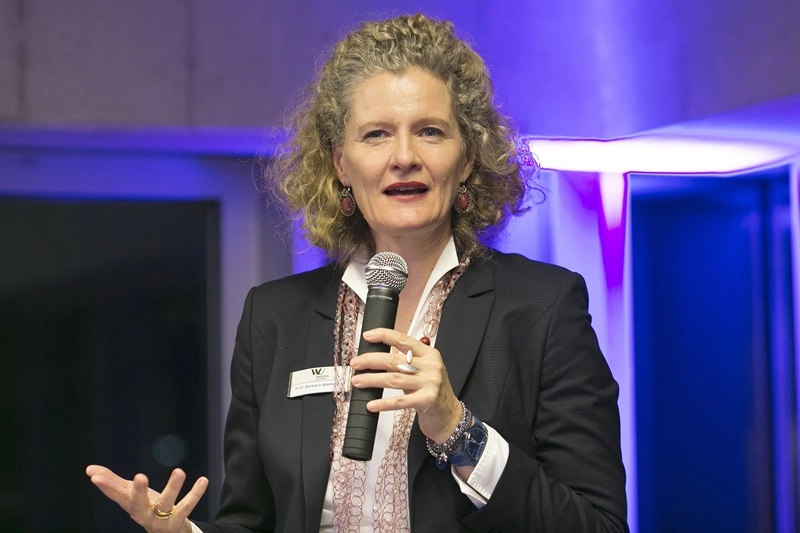The heroic leader is a thing of the past. What is the ideal leader today?
What is the ideal leader like in today's world? Is there one at all? Why are leaders not superheroes? How are expectations evolving, why is self-awareness becoming more important and why is it a turning point when the percentage of women leaders reaches 30%? We spoke to Barbara Stöttinger, Dean of the Leadership Academy at the Vienna University of Economics and Business (WU).

How would you describe the ideal leader in the current situation? What are their skills and abilities?
I think that regardless of the current situation, this is the million dollar question. The ideal is hard to define, as it depends on the circumstances, the people, the company, but we can talk about what an organisation needs from a leader these days, and what they need to be good at, what skills they need to master.
We cannot ignore the unique situation that leaders are currently facing. Being a leader has always been a challenge, with many opportunities and difficult situations, but today the dynamics of change and the simultaneous challenges create a unique situation. We are facing a political crisis, as we are confronted with a number of political, social tensions and even war conflicts in many regions of the world, which is also causing the economic situation to be very volatile. In addition, there are many changes taking place that could affect entire industries and businesses, significantly disrupting the way things have been done so far. Just think of artificial intelligence, where we are still in the early stages, development could take many directions and no one knows at this stage exactly what will emerge.
Basically, leaders need what we call a leadership toolkit: part of it is, how do you make decisions, how do you process information, how do you work with your team? But they also need to be aware of what's going on around them - they need to be aware, for example, of the potential of AI, but also of the potential threats it poses to the business. They don't need to understand everything, but it's important to be able to assess when and what decisions they need to make.
With all these expectations, we must remember that leaders are people too. Therefore, in addition to resilience, they must also reflect that they care about themselves, because only then can they have enough positive energy to perform well.
I wanted to ask about this, that the expectations of managers sometimes seem almost superhuman, but we are talking about people with flaws and shortcomings?
Yes, it is a very dangerous expectation, because there may come a time when no one will want to take the leadership positions, or only the wrong people will apply for them. The perception that a leader can do it all in one person is obsolete. We need to be aware of the reality of expectations. One of the most important tasks of a leader is to build good collaboration within the company, motivate teams and give them a common purpose.
Have you created your leadership toolkit, what should definitely be in this toolkit?
It's hard to generalise, but there are certain basics everyone needs: for example, financial literacy, an understanding of geopolitics, technology, knowledge that can be used to make the necessary connections. The leader doesn't necessarily need to be the best expert in the field, but someone who can connect well with the experts to make good decisions, to move in the right direction.
You must also have excellent interpersonal skills to build good teams, create a working environment where they can develop, get the best out of themselves. Select the right people for the right job.
This has been part of the leadership development literature for years, and is nothing new. What is new is the dynamism of it all, the speed, the complexity, which can be overwhelming because the leader feels out of control. You have to be able to accept this, and even switch perspectives, that there are times when you can be in control, but in other situations (such as the pandemic) everyone is just a 'passenger' when you have to make the best of the circumstances. Navigating this is a serious task.
What can you do to help leaders deal with these challenges?
The leader's personality is an important issue here, as is their ability to manage their own energies. Assess that they are running a marathon, not a sprint. They need to find moments of calm, relaxation and recharging, and to do this they need self-awareness and self-awareness, which is more important than it used to be. Otherwise, those in leadership positions are at risk of burnout. Because, as we have already said, we are not superheroes, when sometimes the challenges are for them. So it is good to have a supportive environment around the leader.

In leadership, self-identity is very important, and one can only convey it if one knows oneself.
Are we still talking about leadership styles, but which can no longer work on their own? What do you think about this?
When we work with other people, we have to respect that they are different. Some people are perfectly happy to see the broader context, to know the direction in which they are developing their own boundaries. While others need guidance towards a common goal. Today, more than ever, it is important for a leader to have a sense of who needs what. As is being able to provide a vision, a vision of where the company is going within the reality of change. It is never 100%, but vision is important, more important than omniscience, because it can provide some stability in a very unstable world.
In what areas do leaders need and can improve?
Here again I would refer to the importance of self-awareness, it is essential that a leader is aware of their strengths and weaknesses, but most importantly, the environment in which they can be at their best. If someone feels that they are not in the right place, in the right position, they are not able to use their energies and motivation to the best of their ability. This can take up a lot of resources. It is better to change.
Insecure situations require a lot more from a leader as a person. It used to be enough to have a place in the hierarchy, but those days are gone. In leadership, self-identity is very important, and it can only be conveyed if you know yourself. This requires self-reflection, much more than, say, 15 years ago.
What changes for a company, and what changes for women working in a company, when women leaders reach 30% of the board
If the percentage of women leaders reaches 30% in the company's board, it means that a woman leader is not alone, there are women around her with whom she can talk, share similar experiences, who can be her allies. It's a mental relief and the support can mean a lot. But for any minority not just women, having 30% of the population present means you are not facing the environment alone, you can have shared ideas from a group of people from the same background.
A minority leader can be a role model for employees. What we are seeing is the reality, if young women see on a company website that there is only one woman on the board or none at all, it sends a message. If a company is making an effort to be diverse and showing it, it's much easier to imagine a relevant candidate in the same role.
You can see the change in the drive for diversity, to reduce the pay gap, but it seems change is still not fast enough?
Why would anyone want to share if they don't have to? The quotas are a good starting point because they create an opportunity for those involved to get their foot in the door. Of course, you then have to prove yourself - perhaps harder than others, since the quota got you the job - but in many cases the opportunity would not be there otherwise. In Austria, there is a quota that 30% of supervisory board seats in public limited companies must be filled by women. Although usually organisations do not go for this because it is not compulsory, they do meet the quota.
Though there is a lot of research that mixed, diverse teams perform better when it is not mandatory, in many cases the people who make the selection choose the people they trust and know the most. This is often due to unconscious biases, which may not be a case against a particular group, they may simply not be the natural choice because they are not in the network of contacts. It is therefore necessary to facilitate this process.
Much has changed, but there is still much work to be done. Change is essential at many levels, one is at the societal level, creating a climate, for example, for women to work alongside their families, to take up leadership positions. The next is at the organisational level, where the issue of quotas, development opportunities and promotions comes into play. I was talking to an HR person in a large company where, for example, what they do is to take all the personal factors out of the CVs of candidates - male or female, age, marital status, etc. - and focus only on achievements. This makes it easier to get more women into the next round of interviews, for example. And for the Vienna Philharmonic, applicants are invited to play behind a curtain, so that the selection committee cannot see them, but only hears the music. Of course, change also requires women themselves, who are willing to take the lead, not reject it or make excuses.
Pictured here with Barbara Stöttinger
